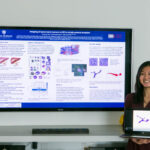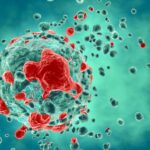Tackling the brain’s barrier
Much like a sentry at a border crossing, the network of tiny blood vessels surrounding the brain only allows a few important molecules in or out. Of course, there is good reason for this. The brain controls the senses, motor skills, breathing, and heart rate, as well as being the seat of thoughts and emotional experiences. Just as our tough plated skull offers a physical armor for the brain, the blood-brain barrier shields our brain from potentially harmful substances at the molecular level.
“Despite its powerful role in controlling bodily functions, the brain is extremely sensitive to chemical changes in environment,” said Peter Searson, director of Johns Hopkins Institute for NanoBioTechnology (INBT) and lead on the Blood Brain Barrier Working Group (BBBWG). The BBBWG is a collaboration between INBT and the Brain Science Institute at the Johns Hopkins School of Medicine.
Oxygen, sugars (such as glucose), and amino acids used to build proteins can enter the brain from the bloodstream with no trouble, while waste products, such as carbon dioxide, exit the brain just as easily. But for most everything else, there’s just no getting past this specialized hurdle. In fact, the blood-brain barrier protects the brain so effectively that it also prevents helpful drugs and therapeutic agents from reaching diseased areas of the brain. And because scientists know very little about the blood-brain barrier, discovering ways to overcome the blockade has been a challenge.
“We still don’t know very much about the structure and function of the blood-brain barrier,” Searson said. “Because we don’t know how the blood-brain barrier works, it presents a critical roadblock in developing treatment for diseases of the central nervous system, including Amyotrophic Lateral Sclerosis (Lou Gehrig’s disease), Alzheimer’s, autism, brain cancer, Huntington’s disease, meningitis, Multiple Sclerosis (MS), neuro-AIDS, Parkinson’s, and stroke. Treatable brain disorders are limited to depression, schizophrenia, chronic pain, and epilepsy. If we had a better understanding of how the blood-brain barrier worked, we would be in a better position to develop treatments for many diseases of the brain,” Searson said. But he added, even with a better understanding of the blood-brain barrier, humans cannot be used to study new therapies.
One way the BBBWG plans to surmount this roadblock is by creating an artificially engineered (or simulated) blood-brain barrier. An engineered artificial blood-brain barrier would allow researchers to conduct studies that simulate trauma to or diseases of the blood-brain barrier, such as stroke, infection, or cancer.
“It would also give us insight into understanding of the role of the blood-brain barrier in aging,” said Searson. Drug discovery and the development of new therapies for central nervous system diseases would be easier with an artificial blood-brain barrier and certainly safer than animal or human testing. Such an artificial membrane could be used as a platform to screen out drugs used to treat maladies outside the brain, but which have unwanted side effects, such as drowsiness.
The creation of such a platform will require the skills of a multidisciplinary team that includes engineers, physicists, neuroscientists and clinicians working together to bring new ideas and new perspectives, Searson added, and will build on recent advances in stem cell engineering and the development of new biomaterials. Current members of the BBBWG include researchers from the departments of neuroscience, anesthesiology, psychiatry, pathology and pharmacology from the Hopkins School of Medicine and from the departments of mechanical engineering, chemical and biomolecular engineering and materials science from the Whiting School of Engineering.
One member of that multidisciplinary team is Lew Romer, MD, associate professor of Anesthesiology and Critical Care Medicine, Cell Biology, Biomedical Engineering, and Pediatrics at the Center for Cell Dynamics at the Johns Hopkins School of Medicine.
“At a cellular level, the focus here is on the adhesive interface of the neurovascular unit – the place where the microcirculation meets the complex parenchyma (or functional surface) of the brain,” Romer said. “This is a durable but delicate and highly specialized region of cell-cell interaction that is responsive to biochemical and mechanical cues.”
Romer said work on the blood-brain barrier is a “fascinating and essential frontier in cell biology and translational medicine, and one that clinicians struggle to understand and work with at the bedsides of some of our sickest and most challenging patients from the ICU’s to the Oncology clinics. Development of an in vitro blood-brain barrier model system” that could be used in molecular biology and engineering manipulations would provide investigators with a powerful window into this vital interface,” Romer added.
Visit the Blood-Brain Barrier Working Group website here.
Watch a student video about current blood-brain barrier research here.
Story by Mary Spiro first appears in the 2012 edition of Nano-Bio Magazine.
Latest Posts
-
 Q&A with PSON Intern Jocelyn Hsu
August 19, 2021
Q&A with PSON Intern Jocelyn Hsu
August 19, 2021
-
 Start Up Founders from Johns Hopkins Aim to Stop Spread of Cancer
August 3, 2021
Start Up Founders from Johns Hopkins Aim to Stop Spread of Cancer
August 3, 2021
-
 Protein Appears to Prevent Tumor Cells from Spreading Via Blood Vessels
July 15, 2021
Protein Appears to Prevent Tumor Cells from Spreading Via Blood Vessels
July 15, 2021


